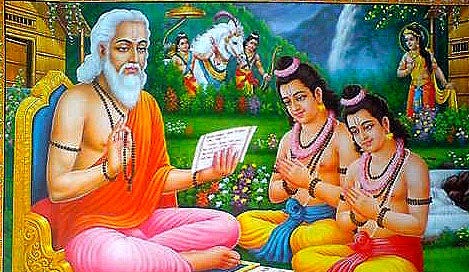Gifts Then and Now
What did Lava and Kusha get as gifts when they sang the Valmiki Ramayana in an august assembly of sages?
As a modern child, you probably get many presents on your birthday. You may also get gifts when you accomplish something. Today you may get colouring kits, dolls, building blocks, toys, a bicycle, and maybe even some electronic gadgets such as a watch or a phone as you grow older.
When you sing a bhajan or a devotional song in front of elders like your grandparents, do they become happy and often give you something? Lava and Kusha had a similar experience.
There was a time long, long ago when Sri Rama and Devi Sita’s sons, Lava and Kusha, were young boys. These twins were radiant and blessed with lovely voices. They grew up in Rishi Valmiki’s ashram and mastered the Vedas with their brilliant intellect and memory. Rishi Valmiki realized that the boys were the best students, and he taught them to sing the entire story of the great queen Sita, also known as the Ramayana.
One day the boys sang the story in an august assembly of sages, saints, and eminent personages. The boys were as handsome and divine as Gandharvas (celestial musicians). The sages were touched by their melodious voices and the depth of emotion in their singing. They praised them and showered them with gifts.
Now, what could the sages have given them as gifts?
The first thing they got was a kalasha. You must have seen the picture of a kalasha, which is a small pot-shaped vessel. It is also called a purnakumbha when it is filled with water or rice. A kalasha is used in many pujas like Varalakshmi Vratam and ceremonies like weddings and grihapraveshams. You can watch a small video about the importance of a kalasha here.
Next, they were given valkalam, or the bark of a tree, which is used as clothing.
A sage who was very happy with their singing gave them black deer skin, yet another gave a cord (rajju) to tie their hair with (jataabandhanam). Some saints were so happy that tears were running down their cheeks at the sweetness of the story and the boys’ voices. They bestowed on them a bundle of sticks to use as firewood, an axe (kuthara), and a rope to tie the firewood.
Another sage gave them a piece of cloth to be tied around as an inner garment (a kaupeenam). Yet another gave the boys a saffron cloth (kaashayam vastram).
The boys also got a kamandalu as a present. Do you know what a kamandalu (or a kamandalam) is? Ascetics and students used kamandalus as small containers to carry water. Some of the kamandalus had spouts too. You may have seen the illustration of a kamandalu in Amar Chitra Katha comics depicting an angry sage sprinkling some water from his kamandalu before pronouncing a curse! To know more about it, watch this video.
Hearing the soulful singing, many sages who had tears in their eyes also chanted hymns to bless the children with a long life.
And this was how the Ramayana, the story of Sita and Rama, first sung by Lava and Kusha, started a long tradition of musicians wandering across the length and breadth of the land of Bhaarata, today known as India.
You can read or listen to this episode of Valmiki Ramayana in the Balakanda, Sarga 4.
So did you like the gifts that little Lava and Kusha got? Do you think their presents were useful to them, as yours are to you?
How different do you think life was then? Would you have liked to be born in those times? Did Lava and Kusha have to worry about recycling toys, or safe disposal of used batteries? Something to discuss with your friends and family!
You can watch an interesting episode from the Ramayana television series where Lava and Kusha sing in the court of King Rama.
And when you grow up, maybe you can read the original Valmiki Ramayana in Sanskrit.




